A Comprehensive Analysis: Attracting and Retaining Staff in Education
VerifiedAdded on 2021/02/21
|11
|3636
|24
Essay
AI Summary
This essay provides a detailed analysis of the crucial topic of attracting and retaining employees within the education sector. It highlights the significance of employee retention for organizational success, emphasizing its impact on productivity, morale, and profitability. The essay explores various factors influencing employee retention, including compensation, preparation and costs to entry, hiring and personnel management, induction and support, and working conditions. It discusses the challenges faced by educators, such as teacher turnover and the need for effective training programs, as well as the impact of salaries and compensation on teacher supply and attrition. Furthermore, the essay delves into strategies for improving recruitment and retention, such as maximizing salaries, providing housing incentives, and offering loan forgiveness programs. It also addresses the importance of strong induction programs, supportive work environments, and the adoption of new teaching methods. The essay concludes by emphasizing the need for talent retention and development to prevent staff turnover and maintain a positive learning environment, highlighting the financial and educational costs associated with losing valuable educators.

Attracting and
retaining staff(revised)
retaining staff(revised)
Paraphrase This Document
Need a fresh take? Get an instant paraphrase of this document with our AI Paraphraser
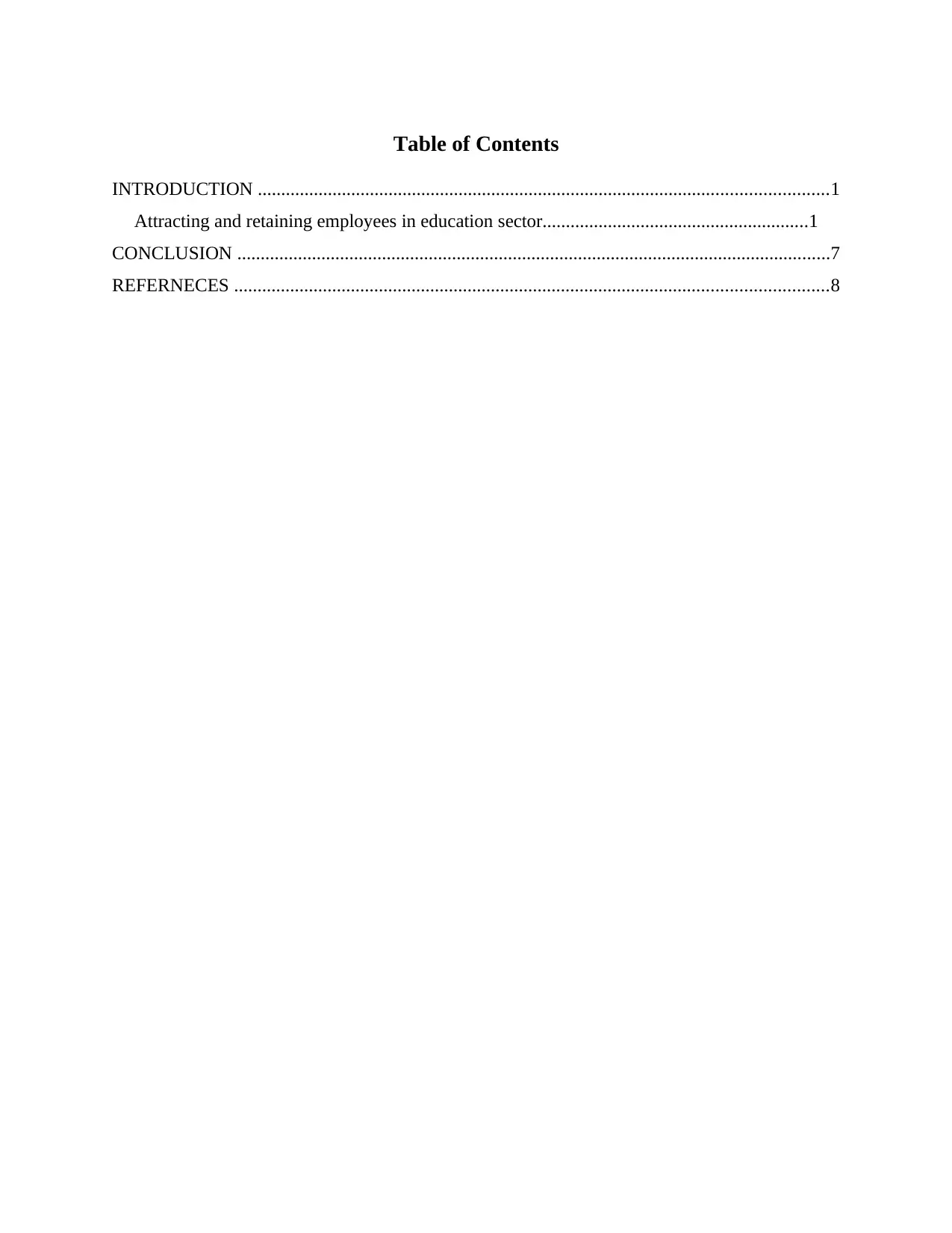
Table of Contents
INTRODUCTION ..........................................................................................................................1
Attracting and retaining employees in education sector.........................................................1
CONCLUSION ...............................................................................................................................7
REFERNECES ...............................................................................................................................8
INTRODUCTION ..........................................................................................................................1
Attracting and retaining employees in education sector.........................................................1
CONCLUSION ...............................................................................................................................7
REFERNECES ...............................................................................................................................8
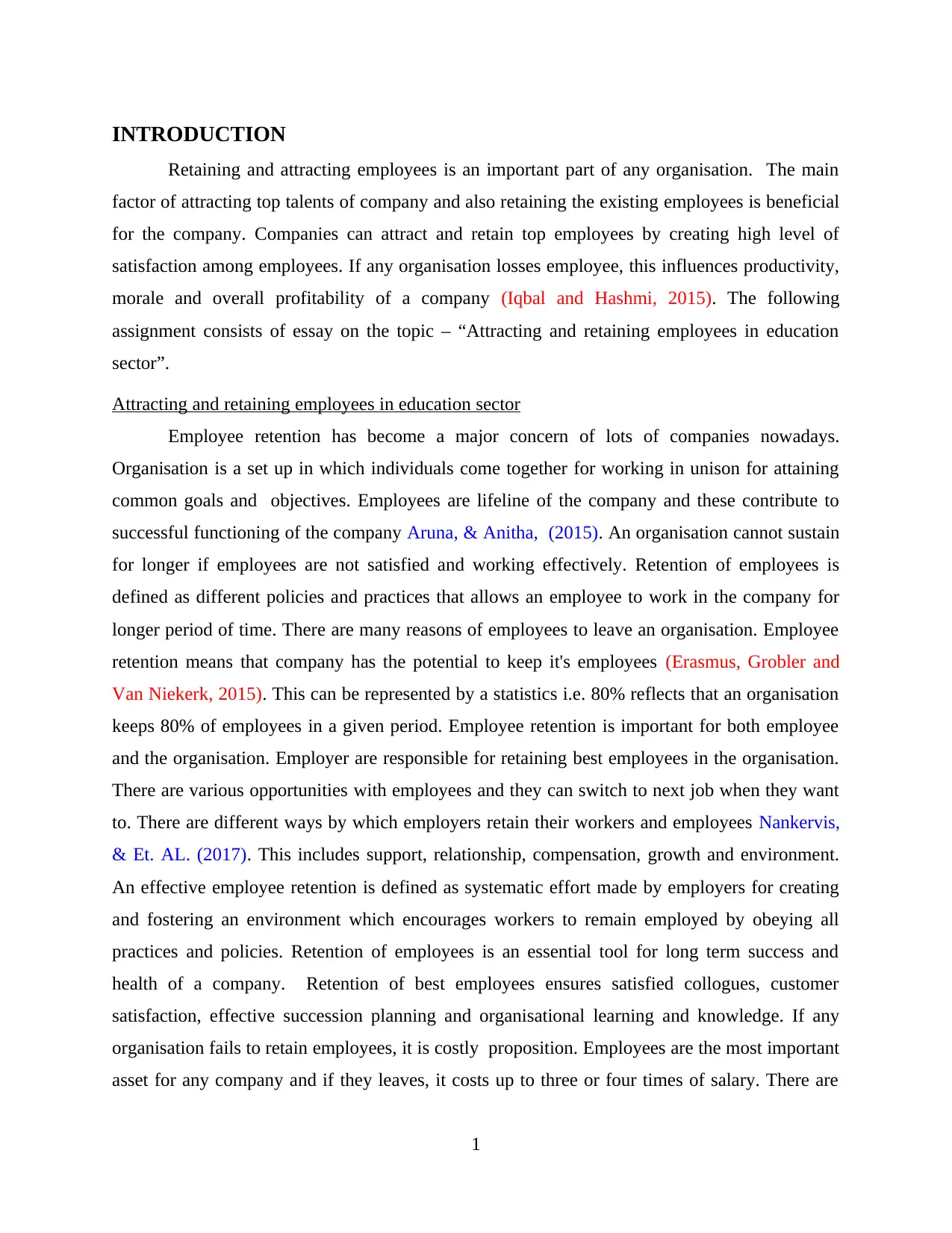
INTRODUCTION
Retaining and attracting employees is an important part of any organisation. The main
factor of attracting top talents of company and also retaining the existing employees is beneficial
for the company. Companies can attract and retain top employees by creating high level of
satisfaction among employees. If any organisation losses employee, this influences productivity,
morale and overall profitability of a company (Iqbal and Hashmi, 2015). The following
assignment consists of essay on the topic – “Attracting and retaining employees in education
sector”.
Attracting and retaining employees in education sector
Employee retention has become a major concern of lots of companies nowadays.
Organisation is a set up in which individuals come together for working in unison for attaining
common goals and objectives. Employees are lifeline of the company and these contribute to
successful functioning of the company Aruna, & Anitha, (2015). An organisation cannot sustain
for longer if employees are not satisfied and working effectively. Retention of employees is
defined as different policies and practices that allows an employee to work in the company for
longer period of time. There are many reasons of employees to leave an organisation. Employee
retention means that company has the potential to keep it's employees (Erasmus, Grobler and
Van Niekerk, 2015). This can be represented by a statistics i.e. 80% reflects that an organisation
keeps 80% of employees in a given period. Employee retention is important for both employee
and the organisation. Employer are responsible for retaining best employees in the organisation.
There are various opportunities with employees and they can switch to next job when they want
to. There are different ways by which employers retain their workers and employees Nankervis,
& Et. AL. (2017). This includes support, relationship, compensation, growth and environment.
An effective employee retention is defined as systematic effort made by employers for creating
and fostering an environment which encourages workers to remain employed by obeying all
practices and policies. Retention of employees is an essential tool for long term success and
health of a company. Retention of best employees ensures satisfied collogues, customer
satisfaction, effective succession planning and organisational learning and knowledge. If any
organisation fails to retain employees, it is costly proposition. Employees are the most important
asset for any company and if they leaves, it costs up to three or four times of salary. There are
1
Retaining and attracting employees is an important part of any organisation. The main
factor of attracting top talents of company and also retaining the existing employees is beneficial
for the company. Companies can attract and retain top employees by creating high level of
satisfaction among employees. If any organisation losses employee, this influences productivity,
morale and overall profitability of a company (Iqbal and Hashmi, 2015). The following
assignment consists of essay on the topic – “Attracting and retaining employees in education
sector”.
Attracting and retaining employees in education sector
Employee retention has become a major concern of lots of companies nowadays.
Organisation is a set up in which individuals come together for working in unison for attaining
common goals and objectives. Employees are lifeline of the company and these contribute to
successful functioning of the company Aruna, & Anitha, (2015). An organisation cannot sustain
for longer if employees are not satisfied and working effectively. Retention of employees is
defined as different policies and practices that allows an employee to work in the company for
longer period of time. There are many reasons of employees to leave an organisation. Employee
retention means that company has the potential to keep it's employees (Erasmus, Grobler and
Van Niekerk, 2015). This can be represented by a statistics i.e. 80% reflects that an organisation
keeps 80% of employees in a given period. Employee retention is important for both employee
and the organisation. Employer are responsible for retaining best employees in the organisation.
There are various opportunities with employees and they can switch to next job when they want
to. There are different ways by which employers retain their workers and employees Nankervis,
& Et. AL. (2017). This includes support, relationship, compensation, growth and environment.
An effective employee retention is defined as systematic effort made by employers for creating
and fostering an environment which encourages workers to remain employed by obeying all
practices and policies. Retention of employees is an essential tool for long term success and
health of a company. Retention of best employees ensures satisfied collogues, customer
satisfaction, effective succession planning and organisational learning and knowledge. If any
organisation fails to retain employees, it is costly proposition. Employees are the most important
asset for any company and if they leaves, it costs up to three or four times of salary. There are
1
⊘ This is a preview!⊘
Do you want full access?
Subscribe today to unlock all pages.

Trusted by 1+ million students worldwide
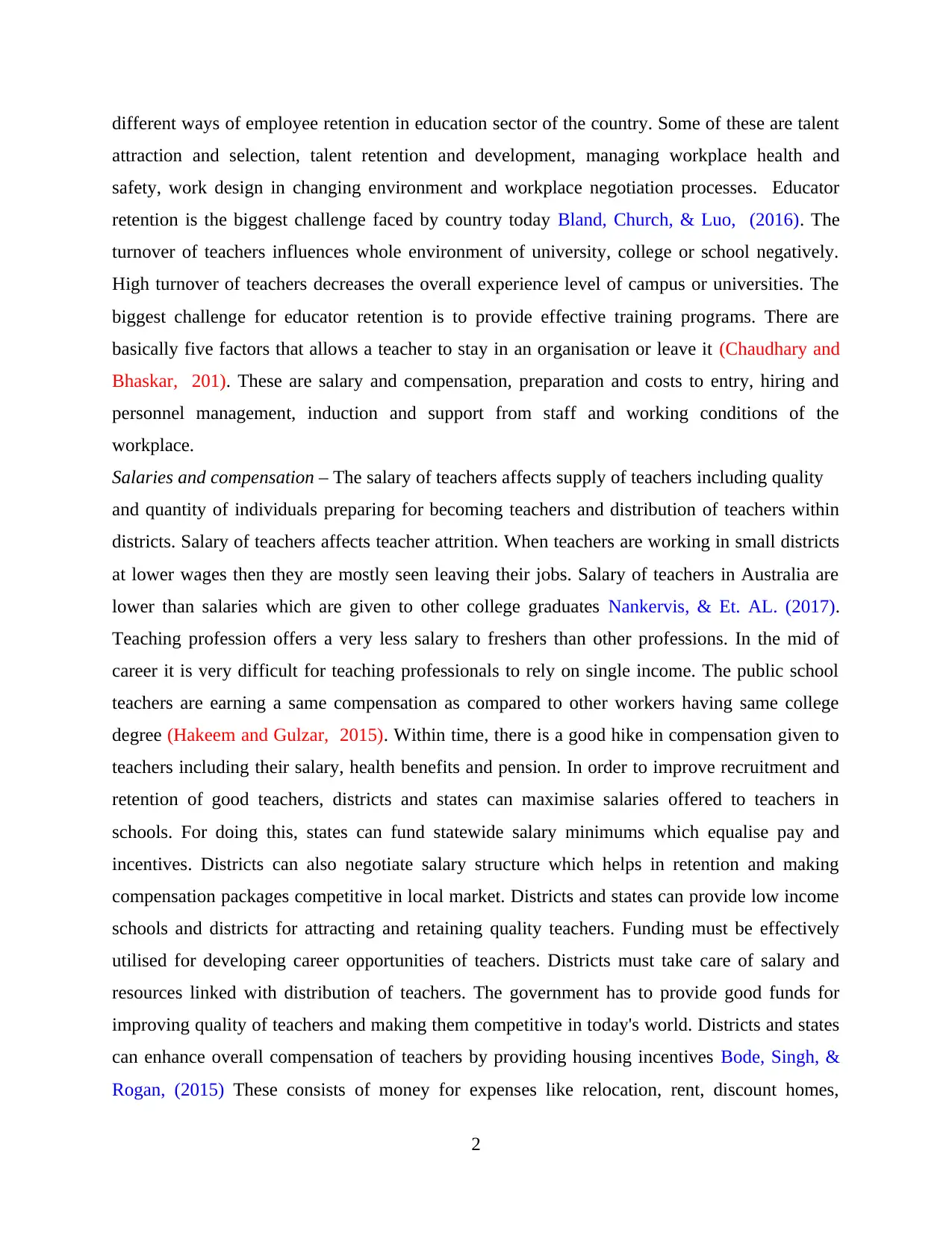
different ways of employee retention in education sector of the country. Some of these are talent
attraction and selection, talent retention and development, managing workplace health and
safety, work design in changing environment and workplace negotiation processes. Educator
retention is the biggest challenge faced by country today Bland, Church, & Luo, (2016). The
turnover of teachers influences whole environment of university, college or school negatively.
High turnover of teachers decreases the overall experience level of campus or universities. The
biggest challenge for educator retention is to provide effective training programs. There are
basically five factors that allows a teacher to stay in an organisation or leave it (Chaudhary and
Bhaskar, 201). These are salary and compensation, preparation and costs to entry, hiring and
personnel management, induction and support from staff and working conditions of the
workplace.
Salaries and compensation – The salary of teachers affects supply of teachers including quality
and quantity of individuals preparing for becoming teachers and distribution of teachers within
districts. Salary of teachers affects teacher attrition. When teachers are working in small districts
at lower wages then they are mostly seen leaving their jobs. Salary of teachers in Australia are
lower than salaries which are given to other college graduates Nankervis, & Et. AL. (2017).
Teaching profession offers a very less salary to freshers than other professions. In the mid of
career it is very difficult for teaching professionals to rely on single income. The public school
teachers are earning a same compensation as compared to other workers having same college
degree (Hakeem and Gulzar, 2015). Within time, there is a good hike in compensation given to
teachers including their salary, health benefits and pension. In order to improve recruitment and
retention of good teachers, districts and states can maximise salaries offered to teachers in
schools. For doing this, states can fund statewide salary minimums which equalise pay and
incentives. Districts can also negotiate salary structure which helps in retention and making
compensation packages competitive in local market. Districts and states can provide low income
schools and districts for attracting and retaining quality teachers. Funding must be effectively
utilised for developing career opportunities of teachers. Districts must take care of salary and
resources linked with distribution of teachers. The government has to provide good funds for
improving quality of teachers and making them competitive in today's world. Districts and states
can enhance overall compensation of teachers by providing housing incentives Bode, Singh, &
Rogan, (2015) These consists of money for expenses like relocation, rent, discount homes,
2
attraction and selection, talent retention and development, managing workplace health and
safety, work design in changing environment and workplace negotiation processes. Educator
retention is the biggest challenge faced by country today Bland, Church, & Luo, (2016). The
turnover of teachers influences whole environment of university, college or school negatively.
High turnover of teachers decreases the overall experience level of campus or universities. The
biggest challenge for educator retention is to provide effective training programs. There are
basically five factors that allows a teacher to stay in an organisation or leave it (Chaudhary and
Bhaskar, 201). These are salary and compensation, preparation and costs to entry, hiring and
personnel management, induction and support from staff and working conditions of the
workplace.
Salaries and compensation – The salary of teachers affects supply of teachers including quality
and quantity of individuals preparing for becoming teachers and distribution of teachers within
districts. Salary of teachers affects teacher attrition. When teachers are working in small districts
at lower wages then they are mostly seen leaving their jobs. Salary of teachers in Australia are
lower than salaries which are given to other college graduates Nankervis, & Et. AL. (2017).
Teaching profession offers a very less salary to freshers than other professions. In the mid of
career it is very difficult for teaching professionals to rely on single income. The public school
teachers are earning a same compensation as compared to other workers having same college
degree (Hakeem and Gulzar, 2015). Within time, there is a good hike in compensation given to
teachers including their salary, health benefits and pension. In order to improve recruitment and
retention of good teachers, districts and states can maximise salaries offered to teachers in
schools. For doing this, states can fund statewide salary minimums which equalise pay and
incentives. Districts can also negotiate salary structure which helps in retention and making
compensation packages competitive in local market. Districts and states can provide low income
schools and districts for attracting and retaining quality teachers. Funding must be effectively
utilised for developing career opportunities of teachers. Districts must take care of salary and
resources linked with distribution of teachers. The government has to provide good funds for
improving quality of teachers and making them competitive in today's world. Districts and states
can enhance overall compensation of teachers by providing housing incentives Bode, Singh, &
Rogan, (2015) These consists of money for expenses like relocation, rent, discount homes,
2
Paraphrase This Document
Need a fresh take? Get an instant paraphrase of this document with our AI Paraphraser
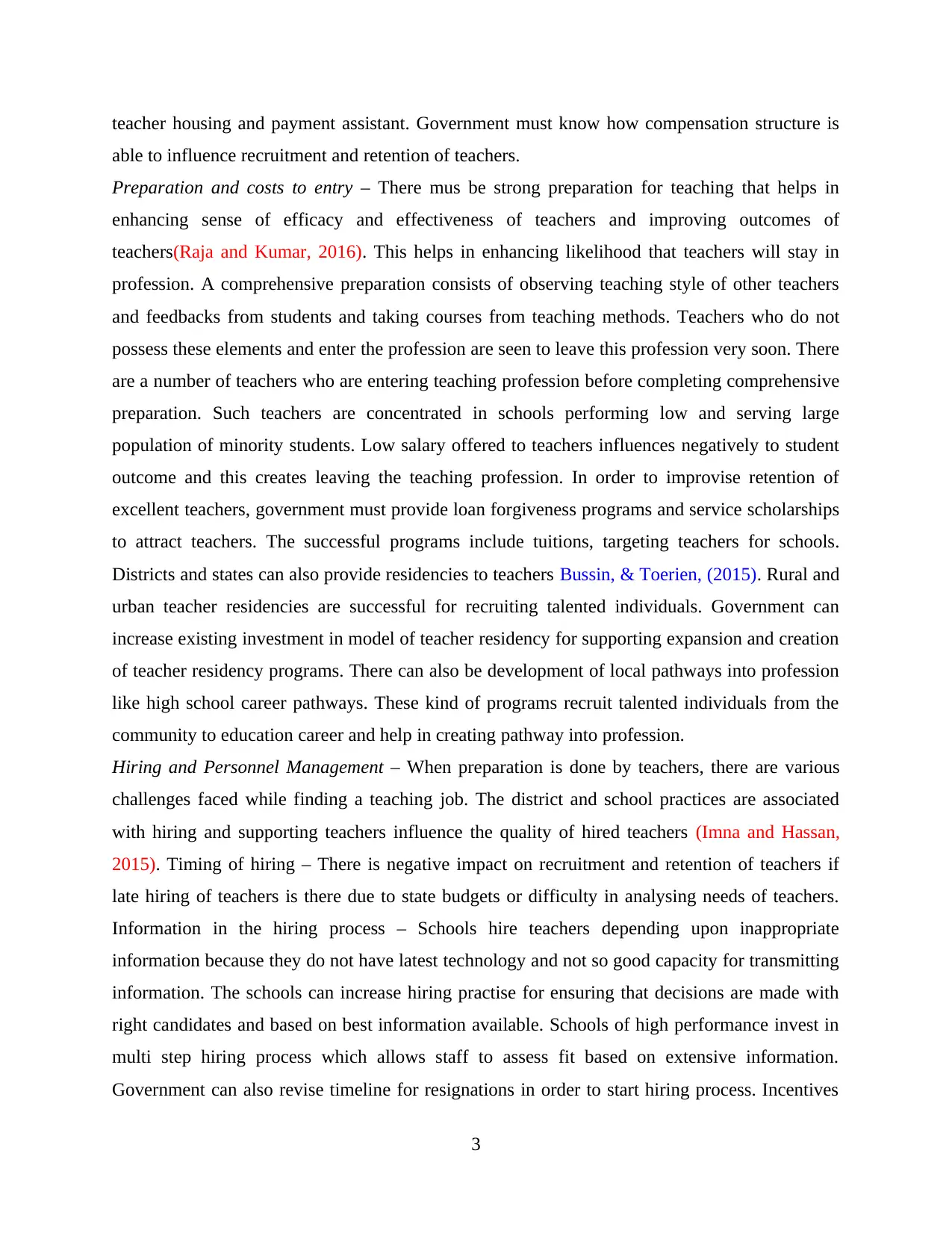
teacher housing and payment assistant. Government must know how compensation structure is
able to influence recruitment and retention of teachers.
Preparation and costs to entry – There mus be strong preparation for teaching that helps in
enhancing sense of efficacy and effectiveness of teachers and improving outcomes of
teachers(Raja and Kumar, 2016). This helps in enhancing likelihood that teachers will stay in
profession. A comprehensive preparation consists of observing teaching style of other teachers
and feedbacks from students and taking courses from teaching methods. Teachers who do not
possess these elements and enter the profession are seen to leave this profession very soon. There
are a number of teachers who are entering teaching profession before completing comprehensive
preparation. Such teachers are concentrated in schools performing low and serving large
population of minority students. Low salary offered to teachers influences negatively to student
outcome and this creates leaving the teaching profession. In order to improvise retention of
excellent teachers, government must provide loan forgiveness programs and service scholarships
to attract teachers. The successful programs include tuitions, targeting teachers for schools.
Districts and states can also provide residencies to teachers Bussin, & Toerien, (2015). Rural and
urban teacher residencies are successful for recruiting talented individuals. Government can
increase existing investment in model of teacher residency for supporting expansion and creation
of teacher residency programs. There can also be development of local pathways into profession
like high school career pathways. These kind of programs recruit talented individuals from the
community to education career and help in creating pathway into profession.
Hiring and Personnel Management – When preparation is done by teachers, there are various
challenges faced while finding a teaching job. The district and school practices are associated
with hiring and supporting teachers influence the quality of hired teachers (Imna and Hassan,
2015). Timing of hiring – There is negative impact on recruitment and retention of teachers if
late hiring of teachers is there due to state budgets or difficulty in analysing needs of teachers.
Information in the hiring process – Schools hire teachers depending upon inappropriate
information because they do not have latest technology and not so good capacity for transmitting
information. The schools can increase hiring practise for ensuring that decisions are made with
right candidates and based on best information available. Schools of high performance invest in
multi step hiring process which allows staff to assess fit based on extensive information.
Government can also revise timeline for resignations in order to start hiring process. Incentives
3
able to influence recruitment and retention of teachers.
Preparation and costs to entry – There mus be strong preparation for teaching that helps in
enhancing sense of efficacy and effectiveness of teachers and improving outcomes of
teachers(Raja and Kumar, 2016). This helps in enhancing likelihood that teachers will stay in
profession. A comprehensive preparation consists of observing teaching style of other teachers
and feedbacks from students and taking courses from teaching methods. Teachers who do not
possess these elements and enter the profession are seen to leave this profession very soon. There
are a number of teachers who are entering teaching profession before completing comprehensive
preparation. Such teachers are concentrated in schools performing low and serving large
population of minority students. Low salary offered to teachers influences negatively to student
outcome and this creates leaving the teaching profession. In order to improvise retention of
excellent teachers, government must provide loan forgiveness programs and service scholarships
to attract teachers. The successful programs include tuitions, targeting teachers for schools.
Districts and states can also provide residencies to teachers Bussin, & Toerien, (2015). Rural and
urban teacher residencies are successful for recruiting talented individuals. Government can
increase existing investment in model of teacher residency for supporting expansion and creation
of teacher residency programs. There can also be development of local pathways into profession
like high school career pathways. These kind of programs recruit talented individuals from the
community to education career and help in creating pathway into profession.
Hiring and Personnel Management – When preparation is done by teachers, there are various
challenges faced while finding a teaching job. The district and school practices are associated
with hiring and supporting teachers influence the quality of hired teachers (Imna and Hassan,
2015). Timing of hiring – There is negative impact on recruitment and retention of teachers if
late hiring of teachers is there due to state budgets or difficulty in analysing needs of teachers.
Information in the hiring process – Schools hire teachers depending upon inappropriate
information because they do not have latest technology and not so good capacity for transmitting
information. The schools can increase hiring practise for ensuring that decisions are made with
right candidates and based on best information available. Schools of high performance invest in
multi step hiring process which allows staff to assess fit based on extensive information.
Government can also revise timeline for resignations in order to start hiring process. Incentives
3
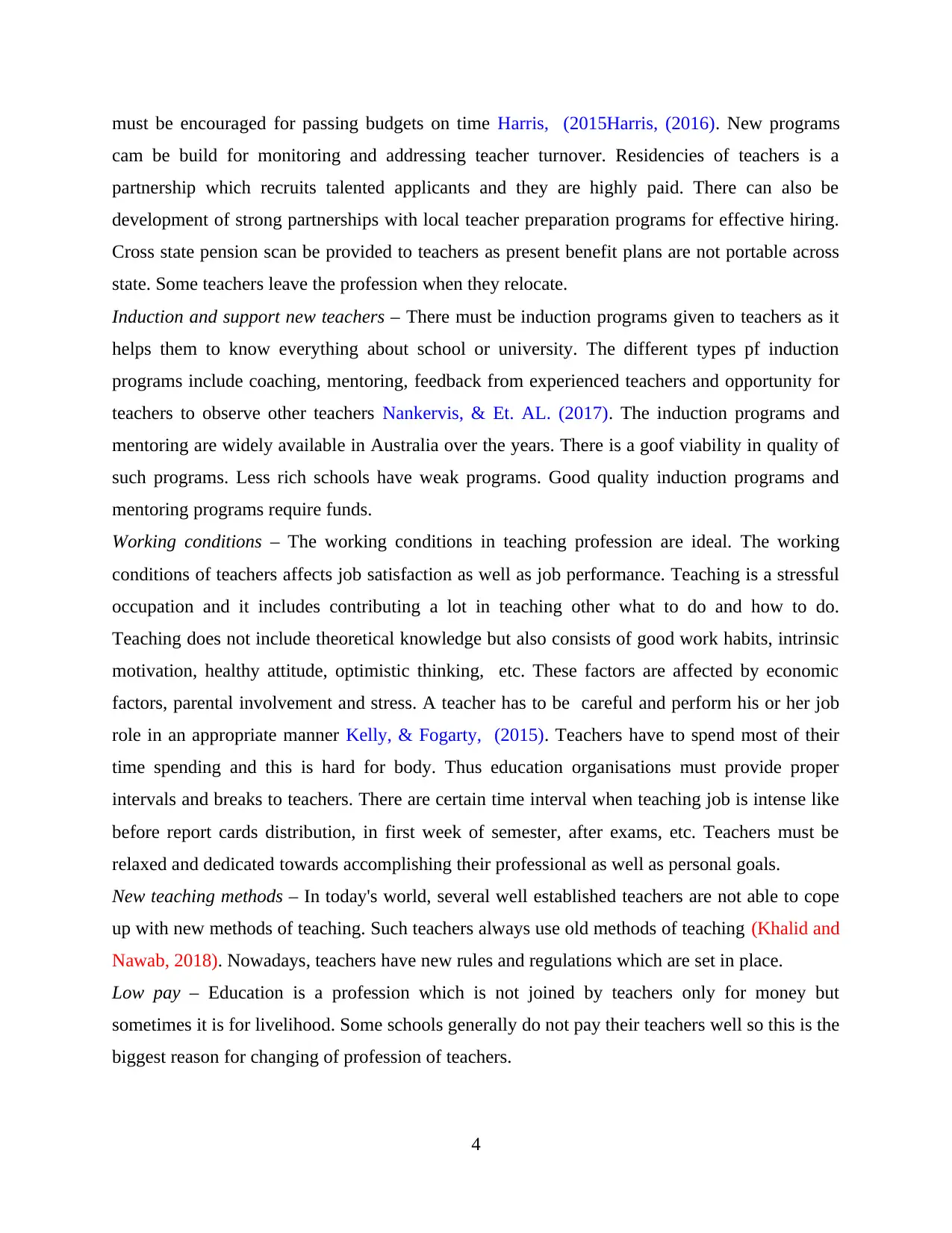
must be encouraged for passing budgets on time Harris, (2015Harris, (2016). New programs
cam be build for monitoring and addressing teacher turnover. Residencies of teachers is a
partnership which recruits talented applicants and they are highly paid. There can also be
development of strong partnerships with local teacher preparation programs for effective hiring.
Cross state pension scan be provided to teachers as present benefit plans are not portable across
state. Some teachers leave the profession when they relocate.
Induction and support new teachers – There must be induction programs given to teachers as it
helps them to know everything about school or university. The different types pf induction
programs include coaching, mentoring, feedback from experienced teachers and opportunity for
teachers to observe other teachers Nankervis, & Et. AL. (2017). The induction programs and
mentoring are widely available in Australia over the years. There is a goof viability in quality of
such programs. Less rich schools have weak programs. Good quality induction programs and
mentoring programs require funds.
Working conditions – The working conditions in teaching profession are ideal. The working
conditions of teachers affects job satisfaction as well as job performance. Teaching is a stressful
occupation and it includes contributing a lot in teaching other what to do and how to do.
Teaching does not include theoretical knowledge but also consists of good work habits, intrinsic
motivation, healthy attitude, optimistic thinking, etc. These factors are affected by economic
factors, parental involvement and stress. A teacher has to be careful and perform his or her job
role in an appropriate manner Kelly, & Fogarty, (2015). Teachers have to spend most of their
time spending and this is hard for body. Thus education organisations must provide proper
intervals and breaks to teachers. There are certain time interval when teaching job is intense like
before report cards distribution, in first week of semester, after exams, etc. Teachers must be
relaxed and dedicated towards accomplishing their professional as well as personal goals.
New teaching methods – In today's world, several well established teachers are not able to cope
up with new methods of teaching. Such teachers always use old methods of teaching (Khalid and
Nawab, 2018). Nowadays, teachers have new rules and regulations which are set in place.
Low pay – Education is a profession which is not joined by teachers only for money but
sometimes it is for livelihood. Some schools generally do not pay their teachers well so this is the
biggest reason for changing of profession of teachers.
4
cam be build for monitoring and addressing teacher turnover. Residencies of teachers is a
partnership which recruits talented applicants and they are highly paid. There can also be
development of strong partnerships with local teacher preparation programs for effective hiring.
Cross state pension scan be provided to teachers as present benefit plans are not portable across
state. Some teachers leave the profession when they relocate.
Induction and support new teachers – There must be induction programs given to teachers as it
helps them to know everything about school or university. The different types pf induction
programs include coaching, mentoring, feedback from experienced teachers and opportunity for
teachers to observe other teachers Nankervis, & Et. AL. (2017). The induction programs and
mentoring are widely available in Australia over the years. There is a goof viability in quality of
such programs. Less rich schools have weak programs. Good quality induction programs and
mentoring programs require funds.
Working conditions – The working conditions in teaching profession are ideal. The working
conditions of teachers affects job satisfaction as well as job performance. Teaching is a stressful
occupation and it includes contributing a lot in teaching other what to do and how to do.
Teaching does not include theoretical knowledge but also consists of good work habits, intrinsic
motivation, healthy attitude, optimistic thinking, etc. These factors are affected by economic
factors, parental involvement and stress. A teacher has to be careful and perform his or her job
role in an appropriate manner Kelly, & Fogarty, (2015). Teachers have to spend most of their
time spending and this is hard for body. Thus education organisations must provide proper
intervals and breaks to teachers. There are certain time interval when teaching job is intense like
before report cards distribution, in first week of semester, after exams, etc. Teachers must be
relaxed and dedicated towards accomplishing their professional as well as personal goals.
New teaching methods – In today's world, several well established teachers are not able to cope
up with new methods of teaching. Such teachers always use old methods of teaching (Khalid and
Nawab, 2018). Nowadays, teachers have new rules and regulations which are set in place.
Low pay – Education is a profession which is not joined by teachers only for money but
sometimes it is for livelihood. Some schools generally do not pay their teachers well so this is the
biggest reason for changing of profession of teachers.
4
⊘ This is a preview!⊘
Do you want full access?
Subscribe today to unlock all pages.

Trusted by 1+ million students worldwide
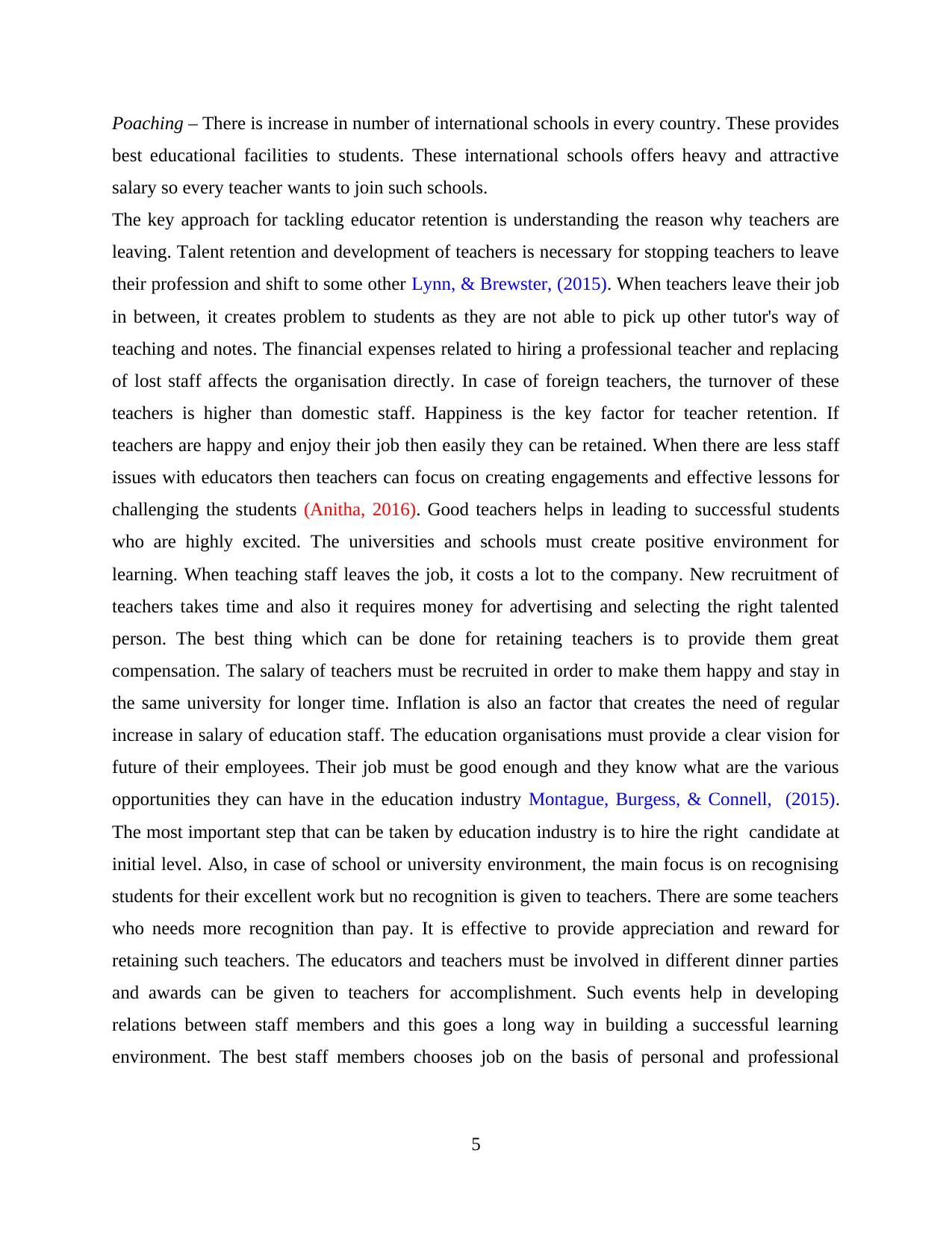
Poaching – There is increase in number of international schools in every country. These provides
best educational facilities to students. These international schools offers heavy and attractive
salary so every teacher wants to join such schools.
The key approach for tackling educator retention is understanding the reason why teachers are
leaving. Talent retention and development of teachers is necessary for stopping teachers to leave
their profession and shift to some other Lynn, & Brewster, (2015). When teachers leave their job
in between, it creates problem to students as they are not able to pick up other tutor's way of
teaching and notes. The financial expenses related to hiring a professional teacher and replacing
of lost staff affects the organisation directly. In case of foreign teachers, the turnover of these
teachers is higher than domestic staff. Happiness is the key factor for teacher retention. If
teachers are happy and enjoy their job then easily they can be retained. When there are less staff
issues with educators then teachers can focus on creating engagements and effective lessons for
challenging the students (Anitha, 2016). Good teachers helps in leading to successful students
who are highly excited. The universities and schools must create positive environment for
learning. When teaching staff leaves the job, it costs a lot to the company. New recruitment of
teachers takes time and also it requires money for advertising and selecting the right talented
person. The best thing which can be done for retaining teachers is to provide them great
compensation. The salary of teachers must be recruited in order to make them happy and stay in
the same university for longer time. Inflation is also an factor that creates the need of regular
increase in salary of education staff. The education organisations must provide a clear vision for
future of their employees. Their job must be good enough and they know what are the various
opportunities they can have in the education industry Montague, Burgess, & Connell, (2015).
The most important step that can be taken by education industry is to hire the right candidate at
initial level. Also, in case of school or university environment, the main focus is on recognising
students for their excellent work but no recognition is given to teachers. There are some teachers
who needs more recognition than pay. It is effective to provide appreciation and reward for
retaining such teachers. The educators and teachers must be involved in different dinner parties
and awards can be given to teachers for accomplishment. Such events help in developing
relations between staff members and this goes a long way in building a successful learning
environment. The best staff members chooses job on the basis of personal and professional
5
best educational facilities to students. These international schools offers heavy and attractive
salary so every teacher wants to join such schools.
The key approach for tackling educator retention is understanding the reason why teachers are
leaving. Talent retention and development of teachers is necessary for stopping teachers to leave
their profession and shift to some other Lynn, & Brewster, (2015). When teachers leave their job
in between, it creates problem to students as they are not able to pick up other tutor's way of
teaching and notes. The financial expenses related to hiring a professional teacher and replacing
of lost staff affects the organisation directly. In case of foreign teachers, the turnover of these
teachers is higher than domestic staff. Happiness is the key factor for teacher retention. If
teachers are happy and enjoy their job then easily they can be retained. When there are less staff
issues with educators then teachers can focus on creating engagements and effective lessons for
challenging the students (Anitha, 2016). Good teachers helps in leading to successful students
who are highly excited. The universities and schools must create positive environment for
learning. When teaching staff leaves the job, it costs a lot to the company. New recruitment of
teachers takes time and also it requires money for advertising and selecting the right talented
person. The best thing which can be done for retaining teachers is to provide them great
compensation. The salary of teachers must be recruited in order to make them happy and stay in
the same university for longer time. Inflation is also an factor that creates the need of regular
increase in salary of education staff. The education organisations must provide a clear vision for
future of their employees. Their job must be good enough and they know what are the various
opportunities they can have in the education industry Montague, Burgess, & Connell, (2015).
The most important step that can be taken by education industry is to hire the right candidate at
initial level. Also, in case of school or university environment, the main focus is on recognising
students for their excellent work but no recognition is given to teachers. There are some teachers
who needs more recognition than pay. It is effective to provide appreciation and reward for
retaining such teachers. The educators and teachers must be involved in different dinner parties
and awards can be given to teachers for accomplishment. Such events help in developing
relations between staff members and this goes a long way in building a successful learning
environment. The best staff members chooses job on the basis of personal and professional
5
Paraphrase This Document
Need a fresh take? Get an instant paraphrase of this document with our AI Paraphraser
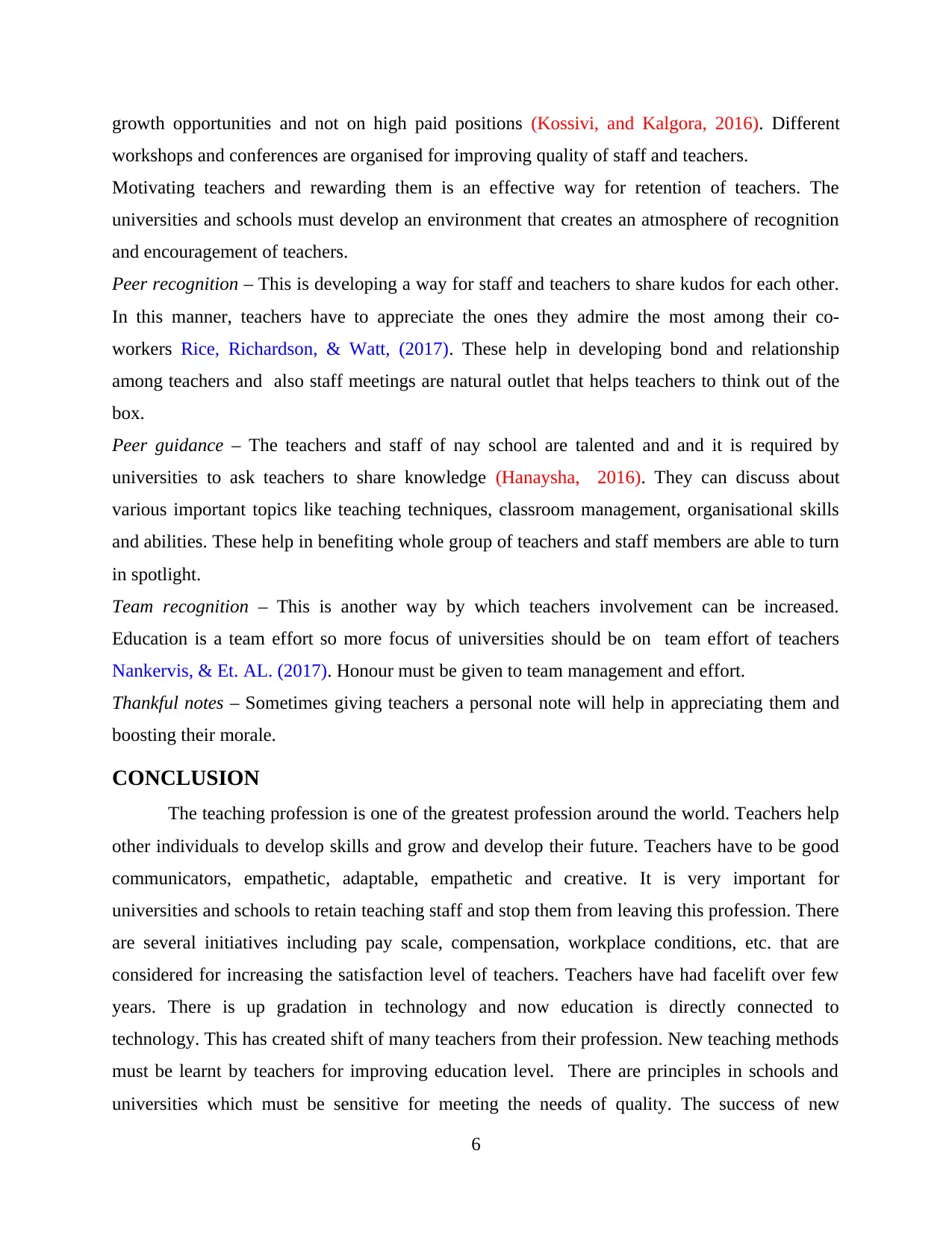
growth opportunities and not on high paid positions (Kossivi, and Kalgora, 2016). Different
workshops and conferences are organised for improving quality of staff and teachers.
Motivating teachers and rewarding them is an effective way for retention of teachers. The
universities and schools must develop an environment that creates an atmosphere of recognition
and encouragement of teachers.
Peer recognition – This is developing a way for staff and teachers to share kudos for each other.
In this manner, teachers have to appreciate the ones they admire the most among their co-
workers Rice, Richardson, & Watt, (2017). These help in developing bond and relationship
among teachers and also staff meetings are natural outlet that helps teachers to think out of the
box.
Peer guidance – The teachers and staff of nay school are talented and and it is required by
universities to ask teachers to share knowledge (Hanaysha, 2016). They can discuss about
various important topics like teaching techniques, classroom management, organisational skills
and abilities. These help in benefiting whole group of teachers and staff members are able to turn
in spotlight.
Team recognition – This is another way by which teachers involvement can be increased.
Education is a team effort so more focus of universities should be on team effort of teachers
Nankervis, & Et. AL. (2017). Honour must be given to team management and effort.
Thankful notes – Sometimes giving teachers a personal note will help in appreciating them and
boosting their morale.
CONCLUSION
The teaching profession is one of the greatest profession around the world. Teachers help
other individuals to develop skills and grow and develop their future. Teachers have to be good
communicators, empathetic, adaptable, empathetic and creative. It is very important for
universities and schools to retain teaching staff and stop them from leaving this profession. There
are several initiatives including pay scale, compensation, workplace conditions, etc. that are
considered for increasing the satisfaction level of teachers. Teachers have had facelift over few
years. There is up gradation in technology and now education is directly connected to
technology. This has created shift of many teachers from their profession. New teaching methods
must be learnt by teachers for improving education level. There are principles in schools and
universities which must be sensitive for meeting the needs of quality. The success of new
6
workshops and conferences are organised for improving quality of staff and teachers.
Motivating teachers and rewarding them is an effective way for retention of teachers. The
universities and schools must develop an environment that creates an atmosphere of recognition
and encouragement of teachers.
Peer recognition – This is developing a way for staff and teachers to share kudos for each other.
In this manner, teachers have to appreciate the ones they admire the most among their co-
workers Rice, Richardson, & Watt, (2017). These help in developing bond and relationship
among teachers and also staff meetings are natural outlet that helps teachers to think out of the
box.
Peer guidance – The teachers and staff of nay school are talented and and it is required by
universities to ask teachers to share knowledge (Hanaysha, 2016). They can discuss about
various important topics like teaching techniques, classroom management, organisational skills
and abilities. These help in benefiting whole group of teachers and staff members are able to turn
in spotlight.
Team recognition – This is another way by which teachers involvement can be increased.
Education is a team effort so more focus of universities should be on team effort of teachers
Nankervis, & Et. AL. (2017). Honour must be given to team management and effort.
Thankful notes – Sometimes giving teachers a personal note will help in appreciating them and
boosting their morale.
CONCLUSION
The teaching profession is one of the greatest profession around the world. Teachers help
other individuals to develop skills and grow and develop their future. Teachers have to be good
communicators, empathetic, adaptable, empathetic and creative. It is very important for
universities and schools to retain teaching staff and stop them from leaving this profession. There
are several initiatives including pay scale, compensation, workplace conditions, etc. that are
considered for increasing the satisfaction level of teachers. Teachers have had facelift over few
years. There is up gradation in technology and now education is directly connected to
technology. This has created shift of many teachers from their profession. New teaching methods
must be learnt by teachers for improving education level. There are principles in schools and
universities which must be sensitive for meeting the needs of quality. The success of new
6
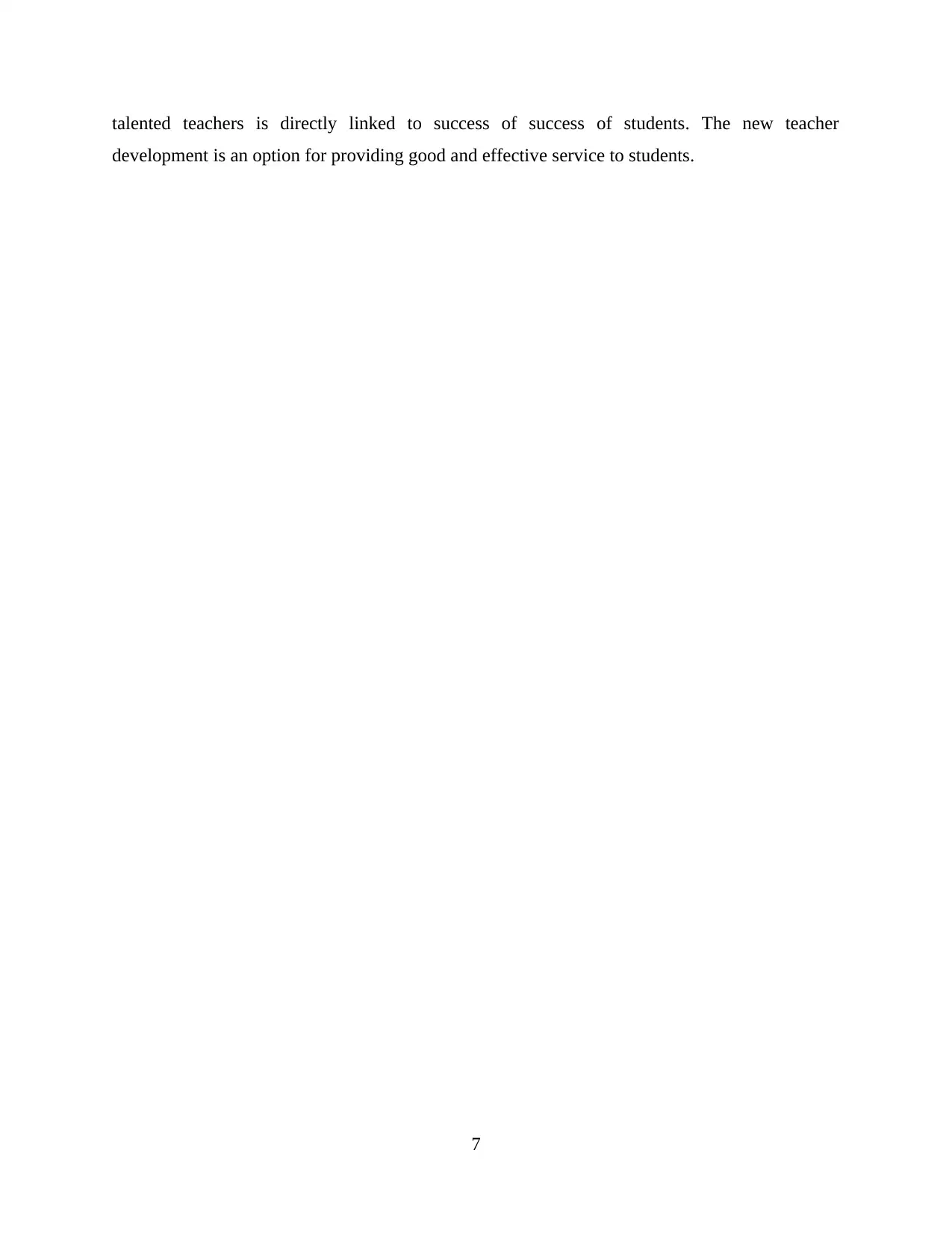
talented teachers is directly linked to success of success of students. The new teacher
development is an option for providing good and effective service to students.
7
development is an option for providing good and effective service to students.
7
⊘ This is a preview!⊘
Do you want full access?
Subscribe today to unlock all pages.

Trusted by 1+ million students worldwide
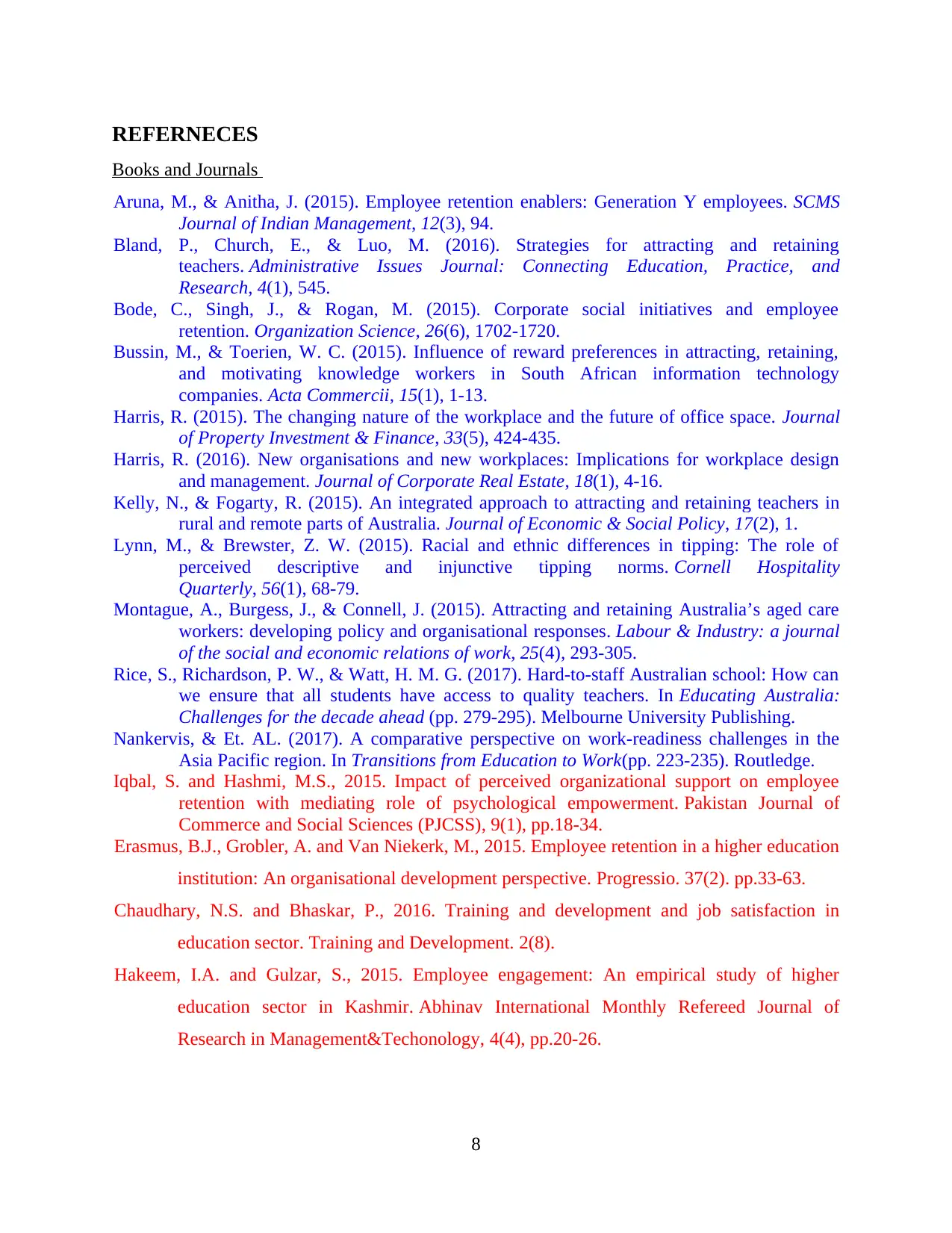
REFERNECES
Books and Journals
Aruna, M., & Anitha, J. (2015). Employee retention enablers: Generation Y employees. SCMS
Journal of Indian Management, 12(3), 94.
Bland, P., Church, E., & Luo, M. (2016). Strategies for attracting and retaining
teachers. Administrative Issues Journal: Connecting Education, Practice, and
Research, 4(1), 545.
Bode, C., Singh, J., & Rogan, M. (2015). Corporate social initiatives and employee
retention. Organization Science, 26(6), 1702-1720.
Bussin, M., & Toerien, W. C. (2015). Influence of reward preferences in attracting, retaining,
and motivating knowledge workers in South African information technology
companies. Acta Commercii, 15(1), 1-13.
Harris, R. (2015). The changing nature of the workplace and the future of office space. Journal
of Property Investment & Finance, 33(5), 424-435.
Harris, R. (2016). New organisations and new workplaces: Implications for workplace design
and management. Journal of Corporate Real Estate, 18(1), 4-16.
Kelly, N., & Fogarty, R. (2015). An integrated approach to attracting and retaining teachers in
rural and remote parts of Australia. Journal of Economic & Social Policy, 17(2), 1.
Lynn, M., & Brewster, Z. W. (2015). Racial and ethnic differences in tipping: The role of
perceived descriptive and injunctive tipping norms. Cornell Hospitality
Quarterly, 56(1), 68-79.
Montague, A., Burgess, J., & Connell, J. (2015). Attracting and retaining Australia’s aged care
workers: developing policy and organisational responses. Labour & Industry: a journal
of the social and economic relations of work, 25(4), 293-305.
Rice, S., Richardson, P. W., & Watt, H. M. G. (2017). Hard-to-staff Australian school: How can
we ensure that all students have access to quality teachers. In Educating Australia:
Challenges for the decade ahead (pp. 279-295). Melbourne University Publishing.
Nankervis, & Et. AL. (2017). A comparative perspective on work-readiness challenges in the
Asia Pacific region. In Transitions from Education to Work(pp. 223-235). Routledge.
Iqbal, S. and Hashmi, M.S., 2015. Impact of perceived organizational support on employee
retention with mediating role of psychological empowerment. Pakistan Journal of
Commerce and Social Sciences (PJCSS), 9(1), pp.18-34.
Erasmus, B.J., Grobler, A. and Van Niekerk, M., 2015. Employee retention in a higher education
institution: An organisational development perspective. Progressio. 37(2). pp.33-63.
Chaudhary, N.S. and Bhaskar, P., 2016. Training and development and job satisfaction in
education sector. Training and Development. 2(8).
Hakeem, I.A. and Gulzar, S., 2015. Employee engagement: An empirical study of higher
education sector in Kashmir. Abhinav International Monthly Refereed Journal of
Research in Management&Techonology, 4(4), pp.20-26.
8
Books and Journals
Aruna, M., & Anitha, J. (2015). Employee retention enablers: Generation Y employees. SCMS
Journal of Indian Management, 12(3), 94.
Bland, P., Church, E., & Luo, M. (2016). Strategies for attracting and retaining
teachers. Administrative Issues Journal: Connecting Education, Practice, and
Research, 4(1), 545.
Bode, C., Singh, J., & Rogan, M. (2015). Corporate social initiatives and employee
retention. Organization Science, 26(6), 1702-1720.
Bussin, M., & Toerien, W. C. (2015). Influence of reward preferences in attracting, retaining,
and motivating knowledge workers in South African information technology
companies. Acta Commercii, 15(1), 1-13.
Harris, R. (2015). The changing nature of the workplace and the future of office space. Journal
of Property Investment & Finance, 33(5), 424-435.
Harris, R. (2016). New organisations and new workplaces: Implications for workplace design
and management. Journal of Corporate Real Estate, 18(1), 4-16.
Kelly, N., & Fogarty, R. (2015). An integrated approach to attracting and retaining teachers in
rural and remote parts of Australia. Journal of Economic & Social Policy, 17(2), 1.
Lynn, M., & Brewster, Z. W. (2015). Racial and ethnic differences in tipping: The role of
perceived descriptive and injunctive tipping norms. Cornell Hospitality
Quarterly, 56(1), 68-79.
Montague, A., Burgess, J., & Connell, J. (2015). Attracting and retaining Australia’s aged care
workers: developing policy and organisational responses. Labour & Industry: a journal
of the social and economic relations of work, 25(4), 293-305.
Rice, S., Richardson, P. W., & Watt, H. M. G. (2017). Hard-to-staff Australian school: How can
we ensure that all students have access to quality teachers. In Educating Australia:
Challenges for the decade ahead (pp. 279-295). Melbourne University Publishing.
Nankervis, & Et. AL. (2017). A comparative perspective on work-readiness challenges in the
Asia Pacific region. In Transitions from Education to Work(pp. 223-235). Routledge.
Iqbal, S. and Hashmi, M.S., 2015. Impact of perceived organizational support on employee
retention with mediating role of psychological empowerment. Pakistan Journal of
Commerce and Social Sciences (PJCSS), 9(1), pp.18-34.
Erasmus, B.J., Grobler, A. and Van Niekerk, M., 2015. Employee retention in a higher education
institution: An organisational development perspective. Progressio. 37(2). pp.33-63.
Chaudhary, N.S. and Bhaskar, P., 2016. Training and development and job satisfaction in
education sector. Training and Development. 2(8).
Hakeem, I.A. and Gulzar, S., 2015. Employee engagement: An empirical study of higher
education sector in Kashmir. Abhinav International Monthly Refereed Journal of
Research in Management&Techonology, 4(4), pp.20-26.
8
Paraphrase This Document
Need a fresh take? Get an instant paraphrase of this document with our AI Paraphraser
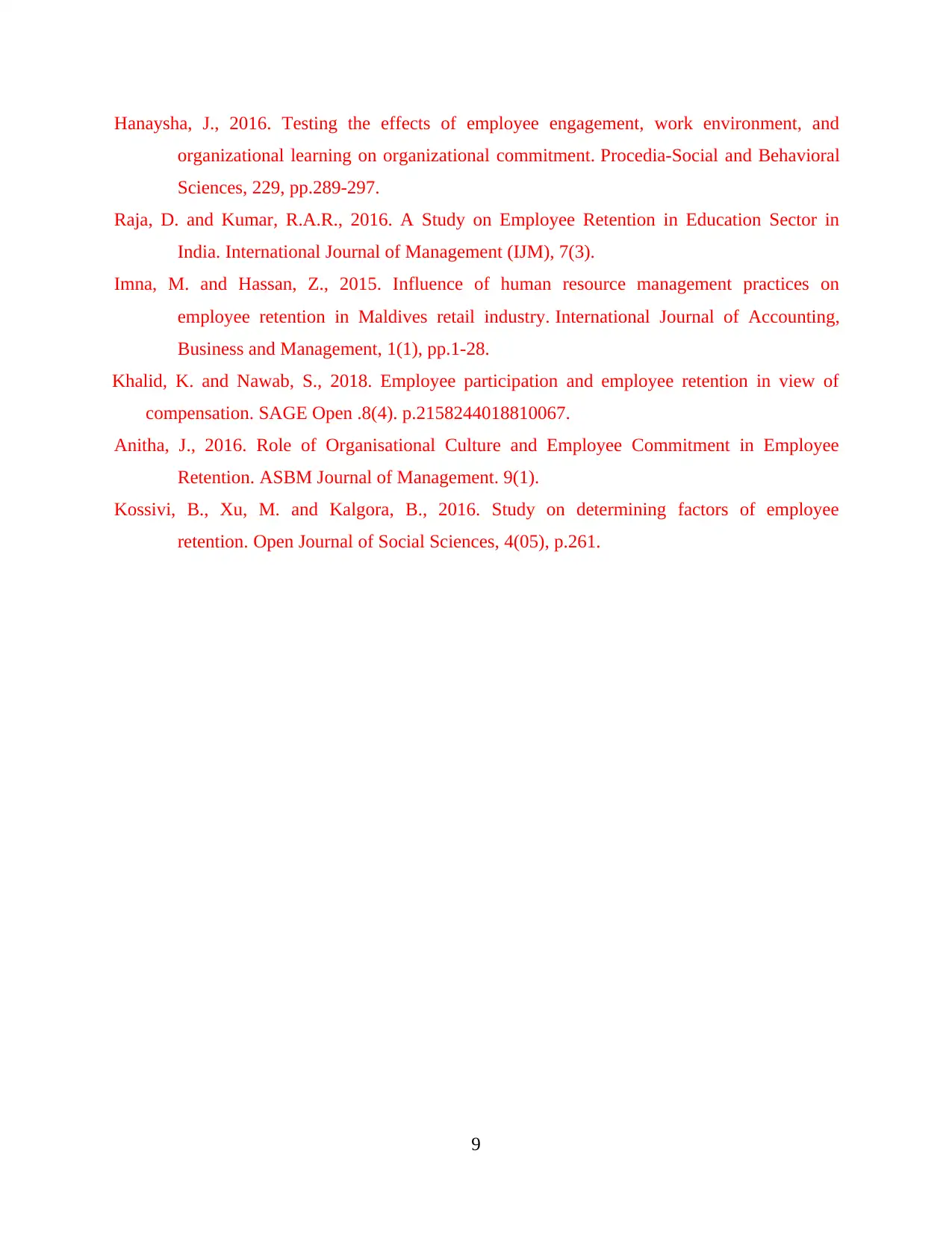
Hanaysha, J., 2016. Testing the effects of employee engagement, work environment, and
organizational learning on organizational commitment. Procedia-Social and Behavioral
Sciences, 229, pp.289-297.
Raja, D. and Kumar, R.A.R., 2016. A Study on Employee Retention in Education Sector in
India. International Journal of Management (IJM), 7(3).
Imna, M. and Hassan, Z., 2015. Influence of human resource management practices on
employee retention in Maldives retail industry. International Journal of Accounting,
Business and Management, 1(1), pp.1-28.
Khalid, K. and Nawab, S., 2018. Employee participation and employee retention in view of
compensation. SAGE Open .8(4). p.2158244018810067.
Anitha, J., 2016. Role of Organisational Culture and Employee Commitment in Employee
Retention. ASBM Journal of Management. 9(1).
Kossivi, B., Xu, M. and Kalgora, B., 2016. Study on determining factors of employee
retention. Open Journal of Social Sciences, 4(05), p.261.
9
organizational learning on organizational commitment. Procedia-Social and Behavioral
Sciences, 229, pp.289-297.
Raja, D. and Kumar, R.A.R., 2016. A Study on Employee Retention in Education Sector in
India. International Journal of Management (IJM), 7(3).
Imna, M. and Hassan, Z., 2015. Influence of human resource management practices on
employee retention in Maldives retail industry. International Journal of Accounting,
Business and Management, 1(1), pp.1-28.
Khalid, K. and Nawab, S., 2018. Employee participation and employee retention in view of
compensation. SAGE Open .8(4). p.2158244018810067.
Anitha, J., 2016. Role of Organisational Culture and Employee Commitment in Employee
Retention. ASBM Journal of Management. 9(1).
Kossivi, B., Xu, M. and Kalgora, B., 2016. Study on determining factors of employee
retention. Open Journal of Social Sciences, 4(05), p.261.
9
1 out of 11
Related Documents
Your All-in-One AI-Powered Toolkit for Academic Success.
+13062052269
info@desklib.com
Available 24*7 on WhatsApp / Email
![[object Object]](/_next/static/media/star-bottom.7253800d.svg)
Unlock your academic potential
Copyright © 2020–2025 A2Z Services. All Rights Reserved. Developed and managed by ZUCOL.




